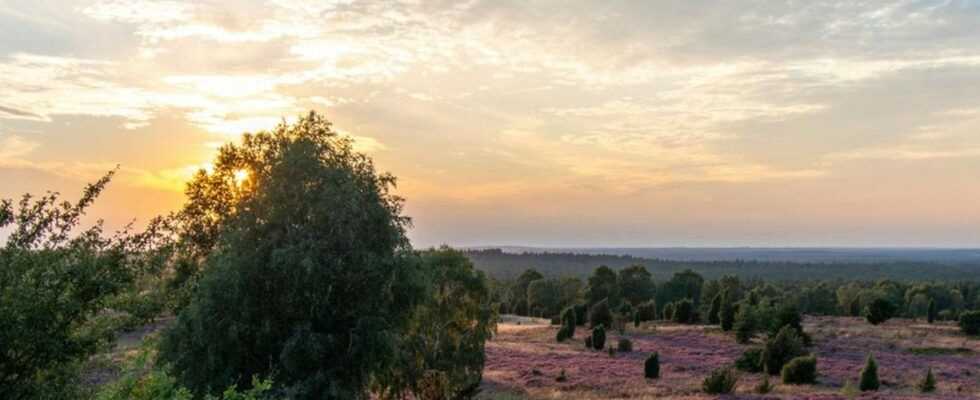The Lüneburg Heath is a dream for nature lovers. What there is to discover here besides the splendor of purple flowers and heather sheep.
Between Hamburg, Bremen and Hanover there is a pearl of Germany: the Lüneburg Heath. With 234 square kilometers, it is the largest contiguous heathland in Central Europe. The landscape is particularly beautiful in August and September, when millions of heather blossoms shine in a strong purple. But there is much more to discover for nature lovers.
Lüneburg Heath: This is where man has lent a hand
The Lüneburg Heath has no natural origins, but was created by humans. Originally, the north German plains were covered by forests. But even in the Bronze Age, settlers used the area for agriculture and cleared oak and pine forests. Barrows can still be found in the Lüneburg Heath today, testifying to the early settlement. In the Middle Ages, the forest stock continued to shrink due to the enormous demand for wood in the saltworks in Lüneburg. Due to the intensive agricultural use, the soil was finally depleted and poor in nutrients. The only thing that could still grow there: the heather.
By the middle of the 18th century, the heather area had expanded so far that heather farmers could use it as pasture for their sheep, the heather sheep, and for beekeeping. At the end of the 19th century, part of the heather was reforested with pine trees and one of the largest forest areas in Germany was created. The heather that is still left needs intensive care. The area around the Wilseder Berg has been under nature protection since 1921. Other nature parks in the region are the Südheide Nature Park and the Elbhöhen-Wendland Nature Park.
Heidschnucken: The Heathen Police
Several herds of Heidschnucken live in the Lüneburg Heath. They are not only beautiful to look at, but also indispensable for the heather. The sheep eat tree sprouts and other plants that would otherwise overgrow the heather. They also trample spider nests, which means that bees can safely collect nectar. The Heidschnucken roam the heath as herds of guarded animals, ten to twelve kilometers a day. Shepherds make sure that the animals do not graze in the same place for too long so that their droppings do not overfertilize the soil.
In addition, a honey tradition has developed among farmers in the Lüneburg Heath since the Middle Ages. Heather honey is a specialty of the region and is a popular souvenir. Harvesting honey is laborious because of its particularly firm consistency and takes place after the six to eight weeks of heather bloom. During this time, beehives, in which the peoples produce the liquid gold, are part of the landscape. Heather honey is characterized by its strong and spicy aroma.
Purple carpet attracts tourists
The blossom of the Lüneburg Heath is the highlight of the year not only for bees, but also for tourists. According to an old rule of thumb, the natural spectacle lasts from August 8th to September 9th, the exact duration of flowering varies with the weather. The purple flowers of the common heather shine particularly brightly in the late afternoon or early evening sun. On the Lüneburg Heath tourism website, nature lovers can find out about the current state of flowering. There are also photo updates of the individual heather areas.
The natural spectacle can easily be explored on foot, by bike or horse-drawn carriage. However, entering the heather is prohibited. Only the narrow, signposted sandy paths are open to onlookers. The Wilseder Berg, which at 169 meters is the highest point in the region, offers a wonderful view of the purple carpet of flowers.
Those who missed the heyday in the Lüneburg Heath can visit the tranquil Schneverdingen. There is a heather garden there, which is home to around 180 different types of heather and which blooms all year round. The observation tower of the heather garden opens up a great panorama of the heather plants and the picturesque stream.
Hikes on premium trails
Active vacationers will also find happiness in the Lüneburg Heath. The Heidschnuckenweg is a highlight. This is one of the most beautiful hiking trails in Germany. It is divided into 13 stages and runs through more than 30 heather areas of the north and south heaths. In addition to open heathland, tourists wander through forests, juniper groves and pass moor areas. Experienced hikers can cover the entire route of 233 kilometers in just under ten days. If you have less time, you can complete sections.
A special experience are full moon hikes, which take place at interesting points on the Heidschnuckenweg from May to the end of October. In the Südheide Nature Park there are also 23 circular hiking trails, all of which start at the designated hiking car park. Depending on their mood, hikers can do short, medium or long tours there.
With the shuttle bus to the natural wonder
Holidaymakers can easily reach the Lüneburg Heath with the Heath Shuttle. From July 15 to October 15, four buses run daily and free of charge between heide locations such as Undeloh or Bispingen and the train stations of Handeloh, Buchholz, Schneverdingen and Soltau on four ring lines. Bicycles are free of charge. Due to the corona pandemic, a mask is required on the buses and passengers are required to keep a distance of at least 1.5 meters.
